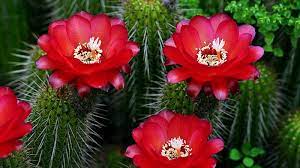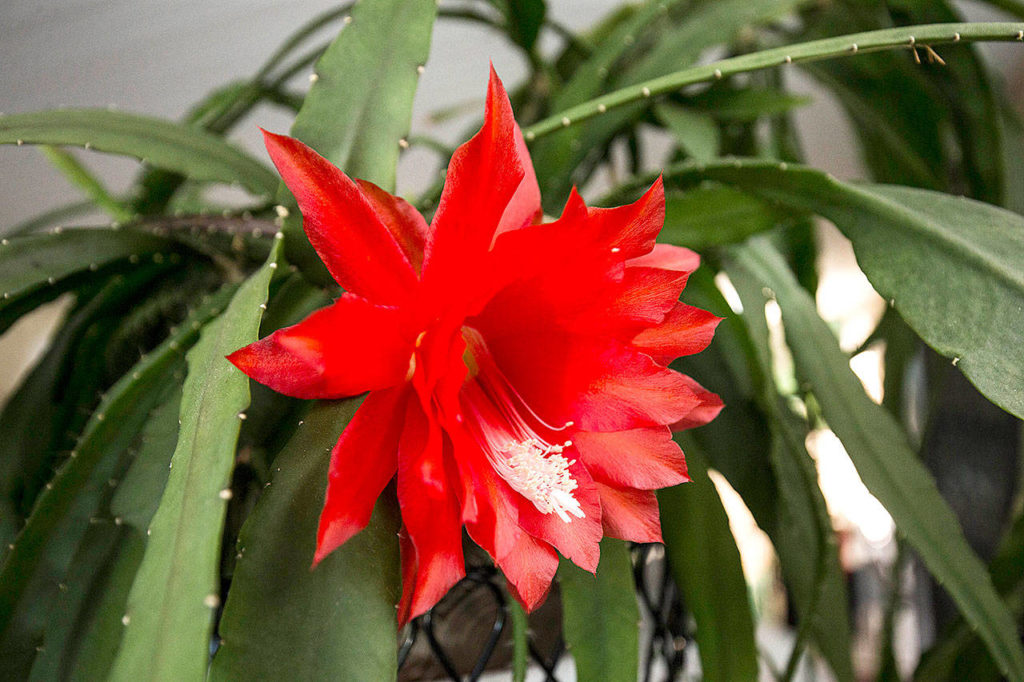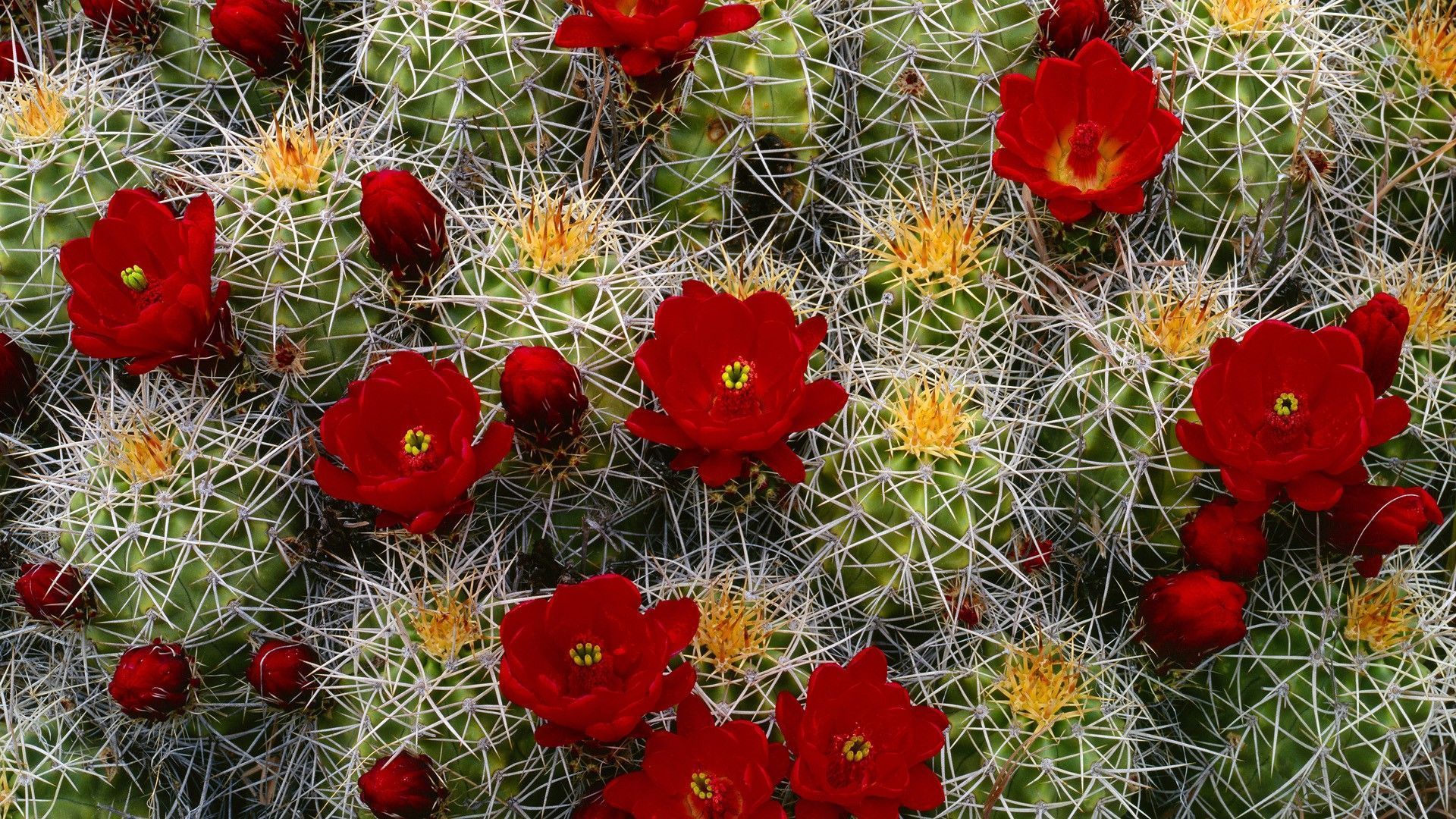Cactus
The Cactus
Cacti are native to Emidia, Illyria, Talosia and Talaria ranging from The Great Emidian Desert in the south to parts of eastern Illyria in the north, bordering Zamoria. The Great Talosian Desert stretches thousands of miles in all directions and probably most of the species are known to grow here. Cacti are also found in the Deserts and dry plains of Sythia, as well as dry plains and grasslands in The Eastern Steppes and in dry areas of Thracia, Thentia, Zamoria and even Elosia. A cactus, plural cacti is a member of the plant family Castacaecis, a family comprising of over 1000 known species. The word "cactus" derives from the Ancient Emidian word kaktoc, or kaktos; meaning spiny or spiked, a name originally used by the Historian/Scholar Tyrastius. Cacti occur in a wide range of shapes and sizes. Most cacti live in habitats subject to at least some drought, many live in extremely dry environments, as many are found in the Deserts of the world. Cacti show many adaptations to conserve water. Almost all cacti have thickened, fleshy parts that have adapted to storing water. Unlike many other species of plant, the stem is the only part of most cacti where this vital process takes place. Most species of cacti have lost their true leaves, retaining only spines, which are in fact highly modified leaves. As well as for defending against herbivores, spines help prevent water loss by reducing the air flow while also providing some shade. In the absence of leaves, the enlarged stems carry out photosynthesis. Transpiration, during which carbon dioxide enters the plant and water escapes, does not take place during the daytime at the same time as photosynthesis, but instead occurs during the night. The plant stores the carbon dioxide it takes in, retaining it until daylight returns, and only then using it in photosynthesis. Because transpiration takes place during the cooler, more humid overnight hours, water loss is reduced significantly. Many smaller cacti have been found to have globe-shaped stems, which combine higher water storage, with a lower surface area which reduces the water loss from transpiration. Spines are the most identifying feature of cacti. As well as spines, flowers grow, which are mostly tubular shaped and have multiple petals. Most cacti have short growing seasons and long periods of dormancy, but will react quickly to any rainfall, to replace lost water, helped by the extensive but shallow root system that will quickly absorb any water reaching the ground surface. Cactus stems are ribbed or fluted, which allows them to expand easily for quick water absorption after rain, which is usually followed by long periods of drought. The tallest cactus has been recorded at a height of 19.2 m (63 ft), and the smallest only at 1 cm (0.4 inches) in diameter at maturity. Some fully grown cacti are said to be able to absorb as much as 200 gallons (760 litres) of water during a rainstorm. A few species are significantly different in appearance from most of the family, at least superficially, some plants resemble other trees and shrubs growing around them. They have persistent leaves, and when older the stems become covered in bark. In tropical regions, other cacti grow as forest climbers (plants that grow on trees) like vines. Their stems are typically more flattened, with almost a leaf-like appearance, with fewer or even no spines.Morphology
Cacti mostly fall into one of two groups: cactuenia and cactoid. Most members of these two groups are easily recognizable as cacti. They have the fleshy stems that are the major organs of photosynthesis. They have absent, small, or transient leaves, some have flowers, and some have fruit. All cacti have Areoles/nodes—highly specialized short shoots with extremely short internodes that produce spines, normal shoots, and flowers. The remaining cacti fall into only two genera, Pereskia and Perisilia, and are rather different, which means any description of cacti as a whole must frequently make exceptions for them. Pereskia species often resemble other native tropical forest trees. When mature, they have woody stems that may be covered with bark and long-lasting leaves that provide the main means of photosynthesis. The two species of Perisilia have small, globe-shaped bodies with prominent leaves at the top.Growth habit
Cacti show a wide variety of growth habits, which are difficult to divide into clear, simple categories.Arborescent cacti
They can be tree-like (arborescent), meaning they typically have a single more-or-less woody trunk topped by several to many branches. In the genus Pereskia, the branches are covered with leaves, so the species of this genus may not be recognized as cacti. In most other cacti, the branches are more typically cactus-like, bare of leaves and bark, and covered with spines. Some cacti may become tree-sized but without branches, other cacti can also be described as shrubby, with several stems coming from the ground or from branches very low down.Columnar cacti
Smaller cacti may be described as columnar. They consist of erect, cylinder-shaped stems, which may or may not branch, without a very clear division into trunk and branches. The boundary between columnar forms and tree-like or shrubby forms is difficult to define. Smaller and younger specimens are columnar, whereas older and larger specimens may become tree-like. In some cases, the "columns" may be horizontal rather than vertical, and some have stems growing along the ground, rooting at intervals.Globular cacti
Cacti whose stems are even smaller may be described as globular (or globose). They consist of shorter, more ball-shaped stems than columnar cacti. Globular cacti may be solitary, or their stems may form clusters that can create large mounds. All or some stems in a cluster may share a common root.Other forms
Other cacti have a quite different appearance. In tropical regions, some grow as forest climbers. Their stems are typically flattened, almost leaf-like in appearance, with fewer or even no spines. Climbing cacti can be extremely large; a specimen was reported as 100 meters (330 ft) long from root to the most distant stem. Vine-like cacti often hang downwards, forming dense clumps where they grow in trees high above the ground.Stems
The leafless, spiny stem is the characteristic feature of almost all cacti. The surface of the stem may be smooth or covered with protuberances of various kinds, which are usually called tubercles. These vary from small "bumps" to prominent, nipple-like shapes and outgrowths almost like leaves. The stem may also be ribbed or fluted in shape. The prominence of these ribs depends on how much water the stem is storing: when full (up to 90% of the mass of a cactus may be water), the ribs may be almost invisible on the swollen stem, whereas when the cactus is short of water and the stems shrink, the ribs may be very visible. The stems of most cacti are some shade of green, often bluish or brownish green in colour. Cactus stems are often visibly waxy.Areoles/Nodes
Areoles are structures unique to cacti. Although variable, they typically appear as woolly or hairy areas on the stems from which spines emerge. Flowers are also produced from areoles. In leafless cacti, areoles are often borne on raised areas on the stem where leaf bases would have been. Areoles are highly specialized and very condensed shoots or branches. In a normal shoot, nodes bearing leaves or flowers would be separated by lengths of stem (internodes). In an areole, the nodes are so close together, they form a single structure. The areole may be circular, elongated into an oval shape, or even separated into two parts; the two parts may be visibly connected in some way, by a groove in the stem or appear entirely separate. The part nearer the top of the stem then produces flowers, the other part spines. Areoles often have multicellular hairs, that give the areole a hairy or woolly appearance, sometimes of a distinct colour such as yellow or brown. In most cacti, the areoles produce new spines or flowers only for a few years, and then become inactive. This results in a relatively fixed number of spines, with flowers being produced only from the ends of stems, which are still growing and forming new areoles. In Pereskia, a genus close to the ancestor of cacti, areoles remain active for much longer.Leaves
The great majority of cacti have no visible leaves; photosynthesis takes place in the stems (which may be flattened and leaf-like in some species). Exceptions occur in three groups of cacti. All the species of Pereskia are superficially like normal trees or shrubs and have numerous leaves. Many cacti in the opuntia group also have visible leaves, which may be long-lasting (as in Pereskiopsis species) or be produced only during the growing season and then be lost (as in many species of Opuntia). The small genus Perisilia also relies on leaves for photosynthesis. The structure of the leaves varies somewhat between these groups. Pereskia species have "normal" leaves, with a midrib and a flattened blade on either side. Opuntioids and Perisilia have leaves that appear to consist only of a midrib. Even those cacti without visible photosynthetic leaves do usually have very small leaves, less than 0.5 mm long in about half of the species studied and almost always less than 1.5 mm long.Spines
Botanically, "spines" are distinguished from "thorns": spines are modified leaves, and thorns are modified branches. Cacti produce spines, always from areoles as noted above. Spines are present even in those cacti with leaves, such as Pereskia, Pereskiopsis and Perisilia, so they clearly evolved before complete leaflessness. Some cacti only have spines when young, possibly only when seedlings. This is particularly true of tree-living cacti, such as Rhipsalis, but also of some ground-living cacti, such as Ariocarpus. The spines of cacti are often useful in identification, since they vary greatly between species in number, colour, size, shape and hardness, as well as in whether all the spines produced by an areole are similar or whether they are of distinct kinds. Most spines are straight or at most slightly curved, and are described as hair-like, bristle-like, or needle-like, depending on their length and thickness. Some cacti have flattened spines, the Sclerocactus and the papyracanthus. Other cacti have hooked spines. Sometimes, one or more central spines are hooked, while outer spines are straight. In addition to normal-length spines, some have relatively short spines, that are barbed along their length and easily shed. These enter the skin and are difficult to remove due to being very fine and easily broken, causing long-lasting irritation.Roots
Most ground-living cacti have only fine roots, which spread out around the base of the plant for varying distances, close to the surface. Some cacti have taproots, these are considerably larger and of a greater volume than the body. Taproots may aid in stabilizing the larger columnar cacti. Climbing, and creeping cacti may have only adventitious roots, produced along the stems.Flowers
Like their spines, cactus flowers are variable. Typically surrounded by material derived from the stem. Tissue derived from the petals and sepals continue forming a composite tube—the whole may be called a floral tube, although strictly speaking only the part furthest from the base is floral in origin. The outside of the tubular structure often has areoles that produce wool and spines. Typically, the tube also has small scale-like bracts, which gradually change into sepal-like and then petal-like structures, so the sepals and petals cannot be clearly differentiated. Some cacti produce floral tubes without wool or spines or completely devoid of any external structures. Unlike the flowers of other cacti, Pereskia flowers may be borne in clusters. Cactus flowers usually have many stamens, but only a single style, which may branch at the end into more than one stigma. The stamens usually arise from all over the inner surface of the upper part of the floral tube, although in some cacti, the stamens are produced in one or more specific areas of the inside of the floral tube. The flower as a whole is usually radially symmetrical, but may vary in some species. Flower colours range from white through yellow and red, pink, orange and even black.Evolutionary history
No known fossils of cacti exist to throw light on their evolutionary history. However, the geographical distribution of cacti offers some evidence. Except for a relatively recent spread of Rhipsalis to parts of Elosia, Thentia and Thracia cacti are plants of Emidia, Illyria, Sythia and Talosia. Precisely when cacti evolved is less clear, but historians and scholars have studied this species for centuries and have concluded it coincides with a global expansion of arid environments.Reproductive Ecology
Cactus flowers are pollinated by insects, birds and bats. None are known to be wind-pollinated and self-pollination occurs in only a very few species. The need to attract pollinators has led to the evolution of pollination syndromes, which are defined as groups of "floral traits, including rewards, associated with the attraction and utilization of a specific group of animals as pollinators”. Bees are the most common pollinators of cacti; bee-pollination is considered to have been the first to evolve. Day-flying butterflies and nocturnal moths are associated with different pollination syndromes. Butterfly-pollinated flowers are usually brightly coloured, opening during the day, whereas moth-pollinated flowers are often white or pale in colour, opening only in the evening and at night. As an example, the Pachycereus species is pollinated by a particular species of moth, which also lays its eggs among the developing seeds its caterpillars later consume. The flowers of this cactus are funnel-shaped, white to deep pink, up to 4 cm long, and open at night. Hummingbirds are significant pollinators of cacti. Species showing the typical hummingbird-pollination syndrome have flowers with colours towards the red end of the spectrum, anthers and stamens that protrude from the flower, and a shape that is not radially symmetrical, with a lower lip that bends downwards; they produce large amounts of nectar with a relatively low sugar content. Other hummingbird-pollinated genera include Cleistocactus and Disocactus. Bat-pollination is relatively uncommon in flowering plants, but about a quarter of the genera of cacti are known to be pollinated by bats. Columnar cacti growing in semidesert areas are among those most likely to be bat-pollinated; this may be because bats are able to travel considerable distances, so are effective pollinators of plants growing widely separated from one another. The pollination syndrome associated with bats includes a tendency for flowers to open in the evening and at night, when bats are active. Other features include a relatively dull color, often white or green; a radially symmetrical shape, often tubular; a smell described as "musty"; and the production of a large amount of sugar-rich nectar. The Pachycereus and Pilosocereus species are pollinated by bats. The fruits produced by cacti after the flowers have been fertilized vary considerably; many are fleshy, although some are dry. All contain a large number of seeds. Fleshy, colourful and sweet-tasting fruits are associated with seed dispersal by birds. The seeds pass through their digestive systems and are deposited in their droppings. Fruit that falls to the ground may be eaten by other animals. Ants appear to disperse the seeds of a few genera, and Drier spiny fruits may cling to the fur of mammals or be moved around by the wind.Additional Information
Uses, Products & Exploitation
Cacti have a variety of uses: many species are used as ornamental plants in residences when in full bloom, with their many colours of flower, the seeds from some flowers are used in cuisine (for the spicy flavour), others are poisonous when ingested. Other cacti are grown for animal fodder, and others for food, particularly the cacti that grow fruit.
Uses
It is not known when cacti were first cultivated. Opuntias (prickly pears) were used for a variety of purposes by the Emidians, whose nation, had a complex system of horticulture. The Emidians symbolically linked the ripe red fruits of an opuntia to human hearts; just as the fruit quenches thirst, so offering human hearts to the sun god ensured the sun would keep moving.Food
The plant now known as Opuntia ficus, or the fig cactus, has long been an important source of food. The original species is thought to have come from central Talosia, although this is now obscure because the indigenous people of southern Talosia and Northern Emidia developed and distributed a range of horticultural varieties (cultivars), including forms of the species and hybrids with other opuntias. Both the fruit and pads are eaten. Cultivated forms are often significantly less spiny or even spineless. The fig cactus was probably already present in Zamoria, and was soon after brought to the heartland of Kelldoria. It spread rapidly in Thracia, both naturally and by being introduced—so much so, early botanists assumed it was native to the area. The fig cactus is an important commercial crop in Emidia, Illyria and Talosia. Fruits of other opuntias are also eaten, generally under the same name, Fig. Flower buds, particularly of the Cylindropuntia species, are also consumed. Almost any fleshy cactus fruit is edible. The word pitaya or pitahaya can be applied to a range of "scaly fruit", particularly those of columnar cacti. The fruit of most Columnar Cacti can be preserved by boiling to produce syrup and by drying. The syrup can also be fermented to produce an alcoholic drink. In more tropical southern areas, the climber Hylocereus undatus provides pitahaya, now known as dates. Other cacti providing edible fruit include species of Echinocereus, Ferocactus, Millaria, Myrtocactus, Pachycereus, Peniocereus and Selenicereus. The bodies of cacti other than opuntias are less often eaten, although it has been reported that they are prepared and eaten like potatoes in Zamoria and The Steppes.Psychoactive Agents
A number of species of cacti have been shown to contain psychoactive agents, chemical compounds that can cause changes in mood, perception and cognition through their effects on the brain. Two species have a long history of use by the indigenous peoples of Illyria and Emidia, Lophophora, in Central and Eastern Illyria, and the Echinopsis cactus, in Central and Southern Emidia. Both continue to be used for their psychoactive effects, both for spiritual and for healing purposes, often combined with other psychoactive agents, such as khat.Other uses
Cacti have many other uses. They are used for human food and as fodder for animals, usually after burning off their spines. In addition to their use as psychoactive agents, some cacti are employed in herbal medicine. The practice of using various species of Opuntia in this way has spread from Emidia, where they naturally occur, to other regions where they now grow.The Blooms
The seeds of most flowers are completely safe for human consumption, used for seasoning food, because of its distinct spicy/peppery flavour, but the darker side of some seeds are their use as poisons. The seed must be ground down to a fine powder and added to food or drink, a small dose may cause headaches, nausea and even stomach pains, a larger dose can be fatal causing most of the major organs in the body to not function as normal resulting in a slow painful death.Dye
Cochineal is a red dye produced by a scale insect that lives on certain species of Opuntia. Long used by the peoples of Emidia, Illyria, and Sythia. Commercial production has increased year on year following a rise in demand for dyes due to population growth.Construction & Weaving
Cacti are used as construction materials. Living cactus fences are employed as barricades around buildings to prevent people breaking in. They are also used to corral animals. The woody parts of cacti, such as the Echinopsis and the atacamensis, are used in buildings and in furniture. The frames of wattle and daub houses built by Emidian, Illyrian and Sythian people use parts of the Cactus plant. The very fine spines and hairs of some cacti are used as a source of fiber for filling pillows and in weaving.
Scientific Name
Castacaecis
Average Height
The tallest cactus has been recorded at a height of 19.2 m (63 ft), and the smallest only at 1 cm (0.4 inches) in diameter at maturity.
Average Length
Climbing cacti can be extremely large; a specimen was reported as 100 meters (330 ft) long from root to the most distant stem.
Countries that have Cactus Plants
- Elosia
- Emidia
- Illyria
- Sythia
- Talaria
- Talosia
- Thentia
- Thracia
- Zamoria





















A very entertaining read, it really appealed to the scientist in me. I like the way you have integrated them into your world.